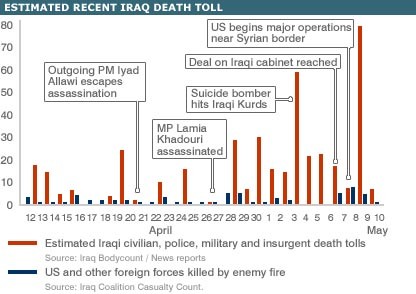
The BBC story on “Suicide Bombs Cause Iraq Carnage” is remarkable, not merely for not identifying the bombers as “insurgents” or “terrorists,” but for the chart above, which aggregates into the “Iraqi death toll” the following categories: “Iraqi civilian, police, military and insurgent death tolls.” The other list is “U.S. and other foreign forces killed by enemy fire.” I doubt that the second category includes the foreign jihadis who have been killed in Iraq, but that’s not an especially huge number. (They do make up virtually all, if not the entirety, of the suicide bombers, however.) More importantly, what sense does it make to lump together the police officers, soldiers, and civilians killed by terrorists and the terrorists themselves into one list? It’s rather like two lists of the dead from World War II: “European civilian, police, military, and Nazi/Fascist death-squad tolls” and “U.S. and other foreign forces killed by enemy fire.” Regardless of what you think about U.S. or other non-European involvement in the European theater in WWII, surely putting the civilian victims of the Nazis and the Nazis themselves on the same list as “European death tolls” would be overlooking an important distinction.
P.S.Note that my opening sentence is somewhat garbled. It should have read:
“The BBC story on ‘Suicide Bombs Cause Iraq Carnage’is remarkable, not merely for failing to identify the ‘insurgents’ as ‘terrorists,’ but for the chart above, which aggregates into the ‘Iraqi death toll’ the following categories: ‘Iraqi civilian, police, military and insurgent death tolls.'”










Tom,
I agree with the substance of your point, but quantitatively do you think it makes a big difference? After all, when a suicide bomber takes out 30 people, we’re talking about the difference between 30 and 29…the numbers would only be relevant if a large fraction of suicide bombers killed only themselves or themselves and 1 or 2 others…
In some cases, it would. The lone suicide bomber is just one guy, but a number of the attacks have involved a suicide bomber (typically, I’ve been told, a foreign jihadi who’s been very carefully cared for and then drugged to the gills so that he’s feeling very good about the prospects for immediate entry into paradise) and a number of other terrorists armed with AK-47s and RPGs, who then hose down the survivors. Some of those men are then killed in the ensuing firefight. Over a longer period of time than that depicted above, it would certainly make a difference. I don’t know enough about the attacks from April 12 to May 10. But even if it were to make a small difference, it’s morally repulsive to lump together the terrorists and their victims in the same list.
By the way, the Canadian Broadcasting Corporation (CBC) has an interesting report on “Casualties in the Iraq War” at:
http://www.cbc.ca/news/background/iraq/casualties.html . The report focuses on the difficulties in knowing just how many people have been killed. (Sometimes it’s not easy to tell by whom they’ve been killed, as bullets don’t have built-in enemy-seeking guidance systems.)
Isn’t it conventional to include both patriot and rebel deaths when measuring the death toll from the American Civil War? (Or is it Yankee invader and patriot deaths?) Perhaps it is too soon to look at the Iraqi death toll from their war in such a fashion.
It seems clear to me that people who are blowing up noncombatant civilians in an effort to create enough chaos that they might be able to seize absolute and tyrannical power don’t belong in the same category as those noncombatants. I would also make the weaker case (weaker in the sense that the victims are combatants or potential combatants) that recruits to the Iraqi police and national guard don’t belong in the same category as fanatical murderers, either.
Tom remarks:
Sometimes it’s not easy to tell by whom they’ve been killed, as bullets don’t have built-in enemy-seeking guidance systems
——
Fortunately, with good ol’ American know-how, this is just a matter of time…
🙂
How is it “morally repulsive” to produce a chart? Isn’t it important to note how many Iraqis have suffered violent deaths due to the US invasion? I’d say the US public could do with a little more examination of just how many Iraqis are dead as a result of our continuing occupation. Of course it would be better to focus on the Iraqi women, children and elderly who’ve suffered agonizing deaths, but the aggregate total of Iraqi dead is also instructive. My opinion is apparently that of the minority. I note that my Catholic church prays only for “our men and women in the military who’ve made the ultimate sacrifice” and even your nemesis Justin Raimondo only runs a count of US casualties, as though dead Iraqis were nothing more than mules or jeeps.
I am strongly in favor of counting, considering, and mourning Iraqi casualties. I don’t think that the people who deliberately inflict those casualties (blowing up car bombs at Shia mosques, in markets, at schools, at power plant openings, and the like) should be mourned or aggregated in with their victims. They should be counted, however. Just not in the same categories as their victims.
The logic of the comment immediately above would lead to just listing “casualties,” without any distinction at all. Distinctions are important, in so far as they convey useful information. It is useful to know what how many Americans have been killed, as also how many Brits, how many Poles, and so on. Similarly for how many Iraqi police, how many Iraqi National Guard members, how many Iraqi noncombatants, and how many Iraqi terrorists. (I should also add how many jihadi terrorists from other countries, as well.) Were I a believer in God, I would pray for the souls of those who were innocent and for the souls of those who were fighting in just causes; I cannot see how I might pray for people who deliberately drop mortar rounds on religious pilgrims, who deliberately massacre people who are peacefully praying, or who deliberately spray machine gun fire into crowds of noncombatants.
TGP: The BBC story on “Suicide Bombs Cause Iraq Carnage” is remarkable, not merely for not identifying the bombers as “insurgents” or “terrorists,”
If you read the BBC story to the end, it DOES identify the bombers as “insurgents.” It describes how “the insurgency appears to be gathering pace.” It then states that “Not since 28 February – when 125 people died in a massive car bombing in Hilla – have insurgents killed so many Iraqis in a single day.” Finally, it asserts that “The insurgents deny suffering such heavy losses.”
Mr. Brady has caught me in an act of bad editing. In rewriting my sentences, I garbled them. I meant to indicate that the article not only did not identify the insurgents “as terrorists,” but — much, much worse — simply lumped them in with the people they had killed. (It was clear that the article referred to them as “insurgents,” so that was unlikely to have been my point, which was that the serious problem was not that the “insurgents” were not more accurately identified as “as terrorists,” but that they were lumped in the count with their victims, which was much more disturbing.) The sentence as it was meant to appear is now in a Post Script above.
To anonymous1…
If I understand you correctly, you’re saying *all* of the current deaths – bombers and their victims both – are “violent deaths due to the US invasion”. I don’t agree with that point of view, but I do understand it.
Perhaps a more interesting chart would be one that is zoomed out so that days on the present chart become years on the new one. Then we could compare the number of Iraqis (innocent civilians and otherwise) killed per year under Saddam to the number of Iraqis killed per year after Saddam.
Would it show a drop in the rate or a rise? Certainly based on the daily death toll reporting, a US citizen could be forgiven for believing more – a lot more – Iraqis are killed per unit of time now than did under Saddam. Somehow, I doubt that’s reality. And that is something I think “the US public could do with a little more examination of.”
(Insert your own conclusions about US news outlets here.)
I hope we all agree that the US government would very much like to see the Iraqi violent death rate fall to 0 immediately. I don’t think the same can be said of the insurgents. Even if we did pull out today. And that helps me decide who is “responsible” for today’s violence.
Richard
“Perhaps a more interesting chart would be one that is zoomed out so that days on the present chart become years on the new one. Then we could compare the number of Iraqis (innocent civilians and otherwise) killed per year under Saddam to the number of Iraqis killed per year after Saddam.”
This is exactly the comparison I’d like to see.
“based on the daily death toll reporting, a US citizen could be forgiven for believing more – a lot more – Iraqis are killed per unit of time now than did under Saddam. Somehow, I doubt that’s reality.”
I haven’t read anyone claim that more Iraqi civilians were killed in an average post-Gulf War year — or any year post-Gulf War — than were killed in 2003 or 2004. Even among the most notorious pro-invasion propagandists this argument is missing. If you or anyone else has evidence to the contrary I’d truly like to evaluate it.
Thanks.
“…what sense does it make to lump together the police officers, soldiers, and civilians killed by terrorists and the terrorists themselves into one list?”
It’s not sensical. Not only is it, as you said, “like two lists of the dead from World War II: ‘European civilian, police, military, and Nazi/Fascist death-squad tolls’ and ‘U.S. and other foreign forces killed by enemy fire,'” but it’s also like the tallying practices that lump the suicide bombers in Israel with their victims, all in one list of the killed.
http://www.jellybean.com